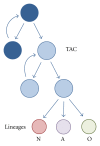Neural stem cells in the diabetic brain
- PMID: 23213341
- PMCID: PMC3505664
- DOI: 10.1155/2012/820790
Neural stem cells in the diabetic brain
Abstract
Experimental diabetes in rodents rapidly affects the neurogenic niches of the adult brain. Moreover, behavioral disorders suggest that a similar dysfunction of the neurogenic niches most likely affects diabetic and prediabetic patients. Here, we review our present knowledge about adult neural stem cells, the methods used for their study in diabetic models, and the effects of experimental diabetes. Variations in diet and even a short hyperglycemia profoundly change the structure and the proliferative dynamics of the neurogenic niches. Moreover, alterations of diabetic neurogenic niches appear to be associated with diabetic cognitive disorders. Available evidence supports the hypothesis that, in the adult, early changes of the neurogenic niches might enhance development of the diabetic disease.
Figures

Similar articles
-
Grafted Subventricular Zone Neural Stem Cells Display Robust Engraftment and Similar Differentiation Properties and Form New Neurogenic Niches in the Young and Aged Hippocampus.Stem Cells Transl Med. 2016 Sep;5(9):1204-15. doi: 10.5966/sctm.2015-0270. Epub 2016 May 18. Stem Cells Transl Med. 2016. PMID: 27194744 Free PMC article.
-
Adult neural stem cells, neurogenic niches, and cellular therapy.Stem Cell Rev. 2006;2(3):213-9. doi: 10.1007/s12015-006-0049-0. Stem Cell Rev. 2006. PMID: 17625257 Review.
-
Exosomes as Novel Regulators of Adult Neurogenic Niches.Front Cell Neurosci. 2016 Jan 19;9:501. doi: 10.3389/fncel.2015.00501. eCollection 2015. Front Cell Neurosci. 2016. PMID: 26834560 Free PMC article. Review.
-
Akhirin regulates the proliferation and differentiation of neural stem cells/progenitor cells at neurogenic niches in mouse brain.Dev Growth Differ. 2020 Feb;62(2):97-107. doi: 10.1111/dgd.12646. Epub 2020 Jan 13. Dev Growth Differ. 2020. PMID: 31943155
-
Circadian Kinetics of Cell Cycle Progression in Adult Neurogenic Niches of a Diurnal Vertebrate.J Neurosci. 2017 Feb 15;37(7):1900-1909. doi: 10.1523/JNEUROSCI.3222-16.2017. Epub 2017 Jan 13. J Neurosci. 2017. PMID: 28087763 Free PMC article.
Cited by
-
Diabetes, adult neurogenesis and brain remodeling: New insights from rodent and zebrafish models.Neurogenesis (Austin). 2017 Jan 31;4(1):e1281862. doi: 10.1080/23262133.2017.1281862. eCollection 2017. Neurogenesis (Austin). 2017. PMID: 28439518 Free PMC article. Review.
-
[Highly selective sodium-glucose co-transporter type 2 inhibitor empagliflozin as means of brain protection in conditions of chronic brain dyscirculation].Probl Endokrinol (Mosk). 2024 Sep 15;70(4):44-56. doi: 10.14341/probl13336. Probl Endokrinol (Mosk). 2024. PMID: 39302864 Free PMC article. Russian.
-
Monitoring neurodegeneration in diabetes using adult neural stem cells derived from the olfactory bulb.Stem Cell Res Ther. 2013 May 14;4(3):51. doi: 10.1186/scrt201. Stem Cell Res Ther. 2013. PMID: 23673084 Free PMC article.
-
Sitagliptin protects proliferation of neural progenitor cells in diabetic mice.Metab Brain Dis. 2015 Aug;30(4):885-93. doi: 10.1007/s11011-015-9656-2. Epub 2015 Feb 20. Metab Brain Dis. 2015. PMID: 25694236
-
Neural Stem Cell-based Regenerative Therapy: A New Approach to Diabetes Treatment.Endocr Metab Immune Disord Drug Targets. 2024;24(5):531-540. doi: 10.2174/1871530323666230512121416. Endocr Metab Immune Disord Drug Targets. 2024. PMID: 37183465 Review.
References
-
- Altman J, Das GD. Autoradiographic and histological evidence of postnatal hippocampal neurogenesis in rats. Journal of Comparative Neurology. 1965;124(3):319–335. - PubMed
-
- Bayer SA, Yackel JW, Puri PS. Neurons in the rat dentate gyrus granular layer substantially increase during juvenile and adult life. Science. 1982;216(4548):890–892. - PubMed
-
- Bonfanti L, Peretto P. Adult neurogenesis in mammals–a theme with many variations. European Journal of Neuroscience. 2011;34(6):930–950. - PubMed
-
- Gage FH, Kempermann G, Palmer TD, Peterson DA, Ray J. Multipotent progenitor cells in the adult dentate gyrus. Journal of Neurobiology. 1998;36(2):249–266. - PubMed
-
- Eriksson PS, Perfilieva E, Björk-Eriksson T, et al. Neurogenesis in the adult human hippocampus. Nature Medicine. 1998;4(11):1313–1317. - PubMed
LinkOut - more resources
Full Text Sources

